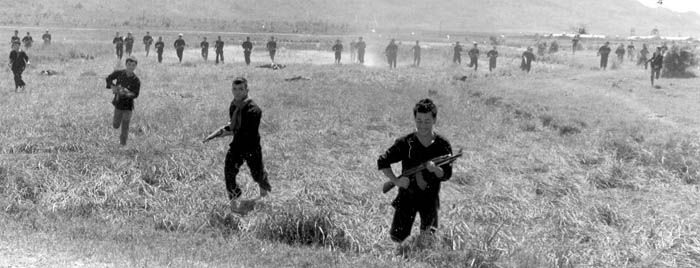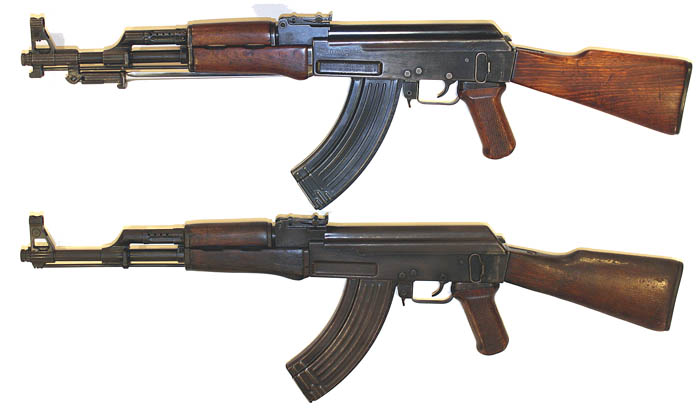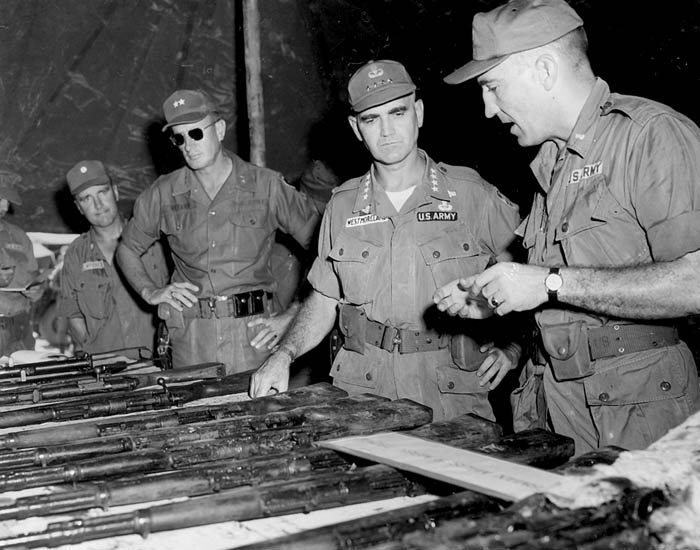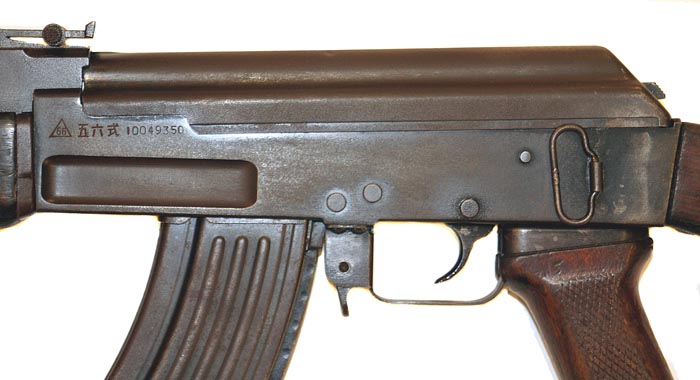By Frank Iannamico
During the post World War II era, Mainland China began to receive various forms of aid from the Soviet Union; in part because of the two countries sharing the same communist ideology, and anti-West polices.
During the 1950-53 Korean War, China aided the Democratic People’s Republic of Korea (communist North Korea) in their struggle with South Korea and the United States. Initially, the aid was limited to material but later they committed a large number of Chinese troops to the fight. Ironically, many of the weapons used by the Chinese troops were American made Thompsons, Grease Guns and even UD-M42 submachine guns given to the Chinese under the U.S. World War II Lend Lease program.

The Russians began to aid an underdeveloped China in increasing its industrial capacity and provided technical assistance predominantly in the manufacture of weapons. The Soviet influence led to indigenous Chinese production of many copies of Russian small arms, particularly the AK and SKS infantry rifles. The Chinese began production of their milled receiver AK rifle, based on the Soviet AK-47 third model, during 1956. With a few minor design and marking variations, the Chinese version of the AK-47 was adopted and designated as the Type 56 rifle. During the 1960-70 era, large numbers of Type 56 milled receiver AK rifles and Chinese manufactured 7.62x39mm ammunition were exported to North Vietnam to assist that country in its war against South Vietnam and the United States. The primary reason for the export of the older milled receiver AK rifles was the new stamped receiver Type 56 models were replacing them in Chinese Army service.
There were a number of different state arsenals in China manufacturing the Type 56 AK pattern rifle. One of the most commonly encountered Chinese AK rifle are those produced in Factory 366. The arsenal stamp of Chinese State Arms Factory 366 is a number 66 enclosed inside a triangle. This facility is located in Hei Long Jiang Province located in northeast China. During the 1980-90 period China North Industries, commonly known as Norinco, exported commercial semiautomatic rifles manufactured at this plant to the U.S. for the civilian market.

Type 56 Model Milled Receiver, 7.62x39mm
The Chinese made several variations of their early 7.62x39mm Type 56 assault rifles based on the Soviet AK-47 with the Type 3 milled receiver. There were wood fixed-stock and underfolding metal stock models. Like most copies of the basic Soviet AK design, China implemented their own small design changes. The top of the protective ears for the front sight post had a closed top with a hole in the center to facilitate the elevation adjustment (although a few Chinese Type 56 rifles have been noted with open-ear style type front sight bases, these are believed to be Russian supplied parts). A letter D was used to mark the 300-meter battle sight position on the rear sight leaf. Other features like the smooth top covers, the 800-meter rear sight calibration and receiver mounted rear sling swivel were identical to the Russian AK-47. All Chinese milled receiver AK rifles had solid wooden stocks (except for the folding stock models) and handguards. Some of the Chinese rifles were fitted with permanently attached folding triangular-shaped spike bayonets. The spike-type bayonet was favored by the Chinese because of the knife-type bayonet’s blade having difficulty penetrating heavy clothing often worn by soldiers fighting in cold climates. The front lower handguard has a slot cut on its underside to accommodate the blade when stored in a folded position. Some early milled receiver Type 56 rifles had barrels that threaded into the receiver (again suspected Russian manufacture), while most had press-fit, pinned barrels. The Type 56-1 model was the Chinese AK with the Soviet pattern underfolding metal stock. The Chinese folding stocks were made from steel stampings. The mode of fire selector lever positions were marked with Chinese characters. There are also Type 56 rifles made for export sales that are marked with Roman characters; L for the automatic position representing continuous or full-automatic, the semiautomatic position marked with a letter D meaning single. Some of the export variants were designated as the model M22 and so marked on the receiver. Others have the Chinese arsenal identification stamp on the left front side of the receiver along with the serial number.

“AK-47” Rifles in the Vietnam War
The AK-47 gained much of its worldwide recognition during the war in Vietnam; U.S. involvement in that conflict that lasted from 1961 until 1975. During this period it was reported that the North Vietnamese Army and Viet Cong Guerillas were armed with AK-47 assault rifles. In reality, many of the weapons, particularly those fielded by the Viet Cong, were of a diverse collection of World War II vintage. During the later years of the war the AK rifles became more prolific, but the vast majority were actually Type 56 AK rifles made in China, not the Soviet made AK-47s as was commonly reported by the media. However, AK-47 became a generic term for all Kalashnikov type assault rifles and this remains true today. Production of the original Russian AK-47 ceased around 1959 and would represent a quite small percentage of the AK-pattern rifles that were eventually manufactured. There were many countries that copied the milled receiver Kalashnikov, but few were designated as the AK-47.
The Chinese Type 56 AK rifles with the forged/milled receivers were the most commonly encountered AK variant used by North Vietnam soldiers and Viet Cong guerillas. There were a very limited number of stamped receiver Type 56 rifles supplied to North Vietnam during their war with the U.S.

The Ultimate Vietnamese War Trophy
During the Vietnam War era it was illegal to bring select-fire AK rifles that were captured during the conflict back to the United States. However, a limited number of the weapons mysteriously made their way to the states. During the brief 1968 Amnesty Program the government allowed the registration of contraband automatic weapons. However, many distrusted the government thinking that the amnesty offer was a ruse and didn’t take advantage of the one-time opportunity to legalize their war trophies. During the poorly announced, little known and very brief 30 day amnesty period in November of 1968, a fair number of military weapons from World War I, World War II, Korea and Vietnam were brought out from their hiding places and registered. Time would prove that not registering a war trophy would become a grave financial and legal error.
The Type 56 Chinese AK rifle featured in this article was originally owned by a US Marine Major who served as the S-3 Operations Officer of the 1st Battalion, 9th Marine Division during 1966-67. The weapon was presented to him by one of the battalion’s company commanders. Fortunately the Major was able to register the weapon in November 1968 during the brief amnesty period. It remained in his possession until recently when it was sold to the current owner. The Type 56 weapon was captured by U.S. Marines in Con Thien, an area in South Vietnam less than two miles south of the six mile wide DMZ (Demilitarized Zone) that separated South Vietnam from North Vietnam. The 1st Battalion, 9th Marines, nicknamed “The Walking Dead” were tasked with providing security of the Con Thien perimeter.

The primary US Marine logistics base in the area was Dong Ha, Con Thien was a 158 meter high mud covered hill that was located in the northwest corner of an area dubbed Leather Neck Square, which consisted of four Marine combat bases; Gio Linh, Dong Ha, Cam Lo and Con Thien. The primary reason for the Marine’s presence in the region was the infiltration routes the North Vietnamese used to move troops and supplies into South Vietnam. Con Thien provided a clear hill top view of the area. If NVA forces were to seize Con Thien, they could subject the rest of Leather Neck Square to accurate long-range artillery and rocket fire, subsequently driving the Marines out of the area.
The Vietnamese name of Con Thien loosely translates to “a place of angels,” but to the Marines that fought there, the name proved to be quite a contradiction in terms. The primary enemy units operating in the area were battalions from the formidable North Vietnamese Army’s 90th NVA Regiment. In the spring of 1967, the NVA began an aggressive push to drive the Marines out of the Con Thien area. The ensuing combat actions consisted of artillery, mortar and even flamethrower attacks by the NVA. Despite taking heavy casualties the Marines held the area. In July 1967, during Operation Buffalo, Companies A and B from the 1st Battalion, 9th Marines were sweeping an area North of Con Thien were engaged by a large NVA force, inflicting heavy casualties on the Marines. The Marines who fought there began to sarcastically refer to the DMZ area as “Dead Marine Zone.” It was some time during these actions the Chinese Type 56 featured in this article was captured.

In 1969, the Marines turned Con Thien over to the South Vietnamese Army’s (ARVN) 1st Division. In November 1971, the poorly trained ARVN 3rd Division replaced the 1st Division, and it was this South Vietnamese unit that finally surrendered the base to the NVA during the March 1972 Communist offensive.
(Special thanks to: Dolf Goldsmith, Todd Gustafson and National Archives II, College Park, MD)
| This article first appeared in Small Arms Review V13N2 (November 2009) |












